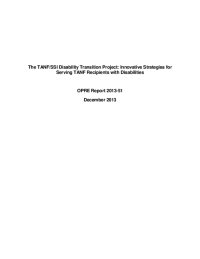The TANF/SSI Disability Transition Project
Innovative Strategies for Serving TANF Recipients with Disabilities
Policymakers and program operators have long worked to understand how state and federal programs can best serve low-income families who are headed by a parent (or parents) with a disability. The Temporary Assistance for Needy Families (TANF) program, administered by the Administration for Children and Families (ACF), serves low-income families, some of whom include individuals who have work limitations or disabilities. The Supplemental Security Income (SSI) program, administered by the Social Security Administration (SSA), serves low-income individuals who are aged, blind, or disabled. While ACF and SSA have common goals of supporting vulnerable populations while encouraging their self-sufficiency and employment, the two agencies’ differing missions, definitions of disability, and rules and incentives related to work pose challenges to clients trying to navigate their way through both programs and to staff members seeking to coordinate their efforts.
In order to understand how best to help TANF recipients with disabilities, ACF and SSA contracted with MDRC to conduct the TANF/SSI Disability Transition Project (TSDTP). The goals of the TSDTP are to explore the connection between the two programs, build knowledge about ways to encourage work among TANF recipients with disabilities, facilitate informed decisions about applying for SSI when appropriate, and help eligible SSI applicants receive awards as quickly as possible while also reducing administrative costs. Through MDRC’s close collaboration with ACF, SSA, and participating state and county TANF agencies, the TSDTP conducted field assessments of existing services for TANF recipients who may have disabilities, tested pilot programs targeted to this population, and analyzed national- and state-level program data. This is the second report from this project. It describes the implementation and findings of three promising pilot interventions.
- Ramsey County, Minnesota, developed a pilot program to increase employment among TANF recipients with work limitations and disabilities. It gathered into the same location mental health services, health care services, and employment services following the Integrated Placement and Support (IPS) model. The results offer promise that IPS, which has been shown to be effective among individuals with severe mental illness, might also be effective for TANF recipients with disabilities. Although the sample size is too small to allow for definitive conclusions, a randomly assigned program group did earn more on average than the control group during the first year.
- Los Angeles County, California, aimed to improve the quality of SSI applications submitted by TANF recipients in order to increase the approval rate at the initial level. Local SSA and Disability Determination Services (DDS) staff members provided training to the county’s SSI advocates, gave feedback on the completeness and quality of submitted SSI applications, and established local liaisons to facilitate coordination and communication. The pilot project improved coordination among the agencies, though the percentage of SSI applications awarded benefits at the initial level remained about the same.
- Muskegon County, Michigan, developed an intervention designed to better identify TANF recipients with disabilities and to improve the employment services offered to TANF clients deemed to have disabilities but to be able to work. The program’s staff used materials drawn from the SSI/SSDI Outreach, Access, and Recovery (SOAR) program to develop medical and case evidence. Using this information, a Medical Review Team made the disability determination and referred recipients determined to be able to work with limitations to individually tailored employment services. Staff members were trained to use motivational interviewing techniques to reduce participants’ barriers to work participation. The pilot lasted only six months, however, and it took time to gather medical documents and make disability determinations, so only a small percentage of recipients received the individually tailored employment services.






